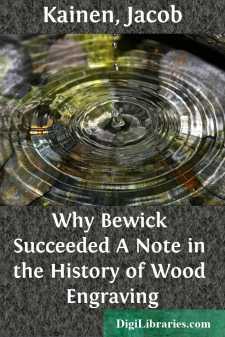Categories
- Antiques & Collectibles 13
- Architecture 36
- Art 48
- Bibles 22
- Biography & Autobiography 813
- Body, Mind & Spirit 142
- Business & Economics 28
- Children's Books 17
- Children's Fiction 14
- Computers 4
- Cooking 94
- Crafts & Hobbies 4
- Drama 346
- Education 46
- Family & Relationships 57
- Fiction 11829
- Games 19
- Gardening 17
- Health & Fitness 34
- History 1377
- House & Home 1
- Humor 147
- Juvenile Fiction 1873
- Juvenile Nonfiction 202
- Language Arts & Disciplines 88
- Law 16
- Literary Collections 686
- Literary Criticism 179
- Mathematics 13
- Medical 41
- Music 40
- Nature 179
- Non-Classifiable 1768
- Performing Arts 7
- Periodicals 1453
- Philosophy 64
- Photography 2
- Poetry 896
- Political Science 203
- Psychology 42
- Reference 154
- Religion 513
- Science 126
- Self-Help 84
- Social Science 81
- Sports & Recreation 34
- Study Aids 3
- Technology & Engineering 59
- Transportation 23
- Travel 463
- True Crime 29
Why Bewick Succeeded A Note in the History of Wood Engraving
by: Jacob Kainen
Description:
Excerpt
The Contemporary View of Bewick
After 1790, when his A general history of quadrupeds appeared with its vivid animals and its humorous and mordant tailpiece vignettes, he was hailed in terms that have hardly been matched for adulation. Certainly no mere book illustrator ever received equal acclaim. He was pronounced a great artist, a great man, an outstanding moralist and reformer, and the master of a new pictorial method. This flood of eulogy rose increasingly during his lifetime and continued throughout the remainder of the 19th century. It came from literary men and women who saw him as the artist of the common man; from the pious who recognized him as a commentator on the vanities and hardships of life (but who sometimes deplored the frankness of his subjects); from bibliophiles who welcomed him as a revolutionary illustrator; and from fellow wood engravers for whom he was the indispensable trail blazer.
During the initial wave of Bewick appreciation, the usually sober Wordsworth wrote in the 1805 edition of Lyrical ballads:
O now that the genius of Bewick were mine,
And the skill which he learned on the banks of the Tyne!
Then the Muses might deal with me just as they chose,
For I'd take my last leave both of verse and of prose.
What feats would I work with my magical hand!
Book learning and books would be banished the land.
If art critics as a class were the most conservative in their estimates of his ability, it was one of the most eminent, John Ruskin, whose praise went to most extravagant lengths. Bewick, he asserted, as late as 1890, " ... without training, was Holbein's equal ... in this frame are set together a drawing by Hans Holbein, and one by Thomas Bewick. I know which is most scholarly; but I do not know which is best." Linking Bewick with Botticelli as a draughtsman, he added: "I know no drawing so subtle as Bewick's since the fifteenth century, except Holbein's and Turner's." And as a typical example of popular appreciation, the following, from the June 1828 issue of Blackwood's Magazine, appearing a few months before Bewick's death, should suffice:
Have we forgotten, in our hurried and imperfect enumeration of wise worthies,—have we forgotten "The Genius that dwells on the banks of the Tyne," the matchless, Inimitable Bewick? No. His books lie in our parlour, dining-room, drawing-room, study-table, and are never out of place or time. Happy old man! The delight of childhood, manhood, decaying age!—A moral in every tail-piece—a sermon in every vignette.
This acclaim came to Bewick not only because his subjects had a homely honesty, but also, although not generally taken into account, because of the brilliance and clarity with which they were printed. Compared with the wood engravings of his predecessors, his were more detailed and resonant in black and white, and accordingly seemed miraculous and unprecedented. He could engrave finer lines and achieve better impressions in the press because of improvements in technology which will be discussed later, but for a century the convincing qualities of this new technique in combination with his subject matter led admirers to believe that he was an artist of great stature.
William Wordsworth, Lyrical ballads, London, 1805, vol. 1. p. 199.
John Ruskin, Ariadne Florentina, London, 1890, pp. 98, 99.
Ibid., p. 246.
Later, more mature judgment has made it plain that his contributions as a craftsman outrank his worth as an artist. He was no Holbein, no Botticelli—it is absurd to think of him in such terms—but he did develop a fresh method of handling wood engraving. Because of this he represents a turning point in the development of this medium which led to its rise as the great popular vehicle for illustration in the 19th century. In his hands wood engraving underwent a special transformation; it became a means for rendering textures and tonal values. Earlier work on wood could not do this; it could manage only a rudimentary suggestion of tones. The refinements that followed, noticeable in the highly finished products of the later 19th century, came as a direct and natural consequence of Bewick's contributions to the art....



